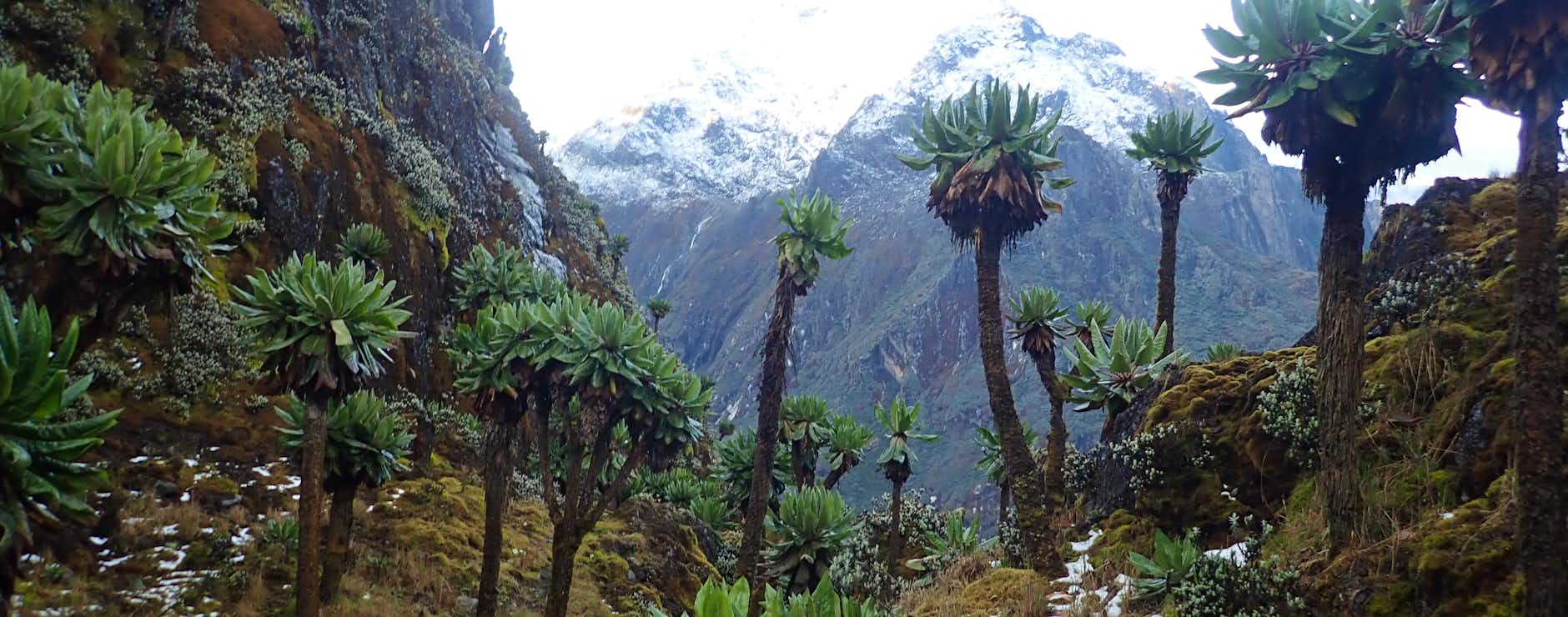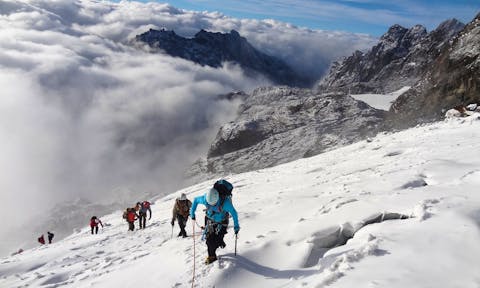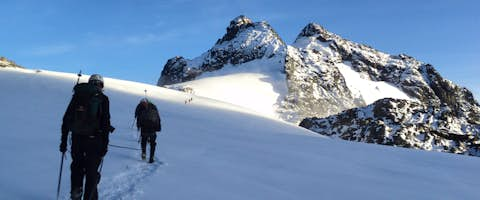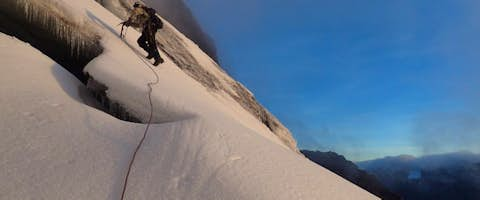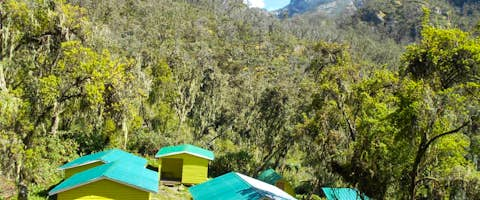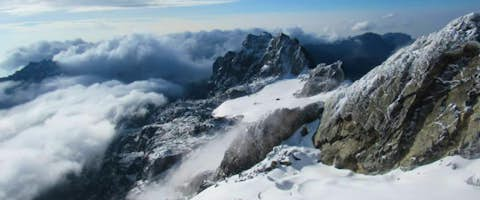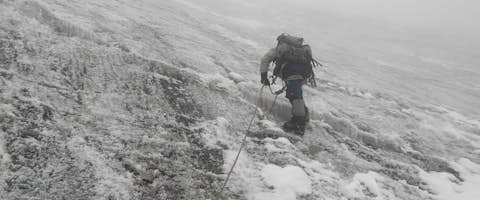A journey through the Rwenzori Mountains
The Scott Elliot pass sits at 4,485 metres, just before the final push towards the summit of Mount Stanley - home to the highest peak in the Rwenzori Mountains. There’s less vegetation up here, but what does grow is striking in appearance; moss protruding from thick branches - mirroring the icicles that dangle higher up - the sea of greens broken only by coral pink orchids.
Climbing higher, snow falls off disturbed rock formations like sugar off a spoon. It is stately, mottled with lichen, the scene would look at home in the Scottish Hebrides, not here in the heart of equatorial Africa.
Between us and the summit, beyond a ridge that joins the Alexandra and Margherita peaks, there are frozen boulders that must be carefully navigated. Heading ever-skywards, surrounded by mist, snow and ice - it’s easy to see why Ptolemy called them the ‘Mountains of the Moon’, all those years ago.

Higher and higher, into the clouds
Ptolemy, the ancient geographer, wrote that the Rwenzoris were discovered by a travelling merchant, a man called Diogenes circa 110 CE.
Ptolemy writes that Diogenes was travelling through East Africa when he accidentally stumbled across the ever-elusive source of the Nile. The source itself emerged from a snow-melt upon what he called ‘Moon Mountains’. These waters pooled into lakes that fed into the river further south.
As the sunlight beams down onto the convex glaciers of the Rwenzoris, there is a clear division in the mountains. The lower foothills are alive with vibrant greens that slowly morph into whites and greys as you ascend past 4,000 metres.
There is nothing quite like this scene, where the warmth of the green forests gives way to a much colder world above. For now, you are planted between them.

Rwenzori is where luscious greens transform to snow-capped peaks.
Depictions of the Mountains of the Moon changed over the centuries as explorers tried to pinpoint their location. In the 17th century, they were described as having hidden lakes stemming from a much larger system deep underground that trickled into the river Nile.
By the 18th century, the mountains were completely left off of some cartographer’s maps, their existence still unverified and the source of the Nile now found elsewhere. Eventually, the Mountains of the Moon vanished from written works and maps, relegated to the pages of fiction.
Upon their rediscovery towards the beginning of the 19th century, the original story of the Moon Mountains became attributed to the icy caps of the Rwenzori Mountains, and it’s a name they’ve championed ever since.
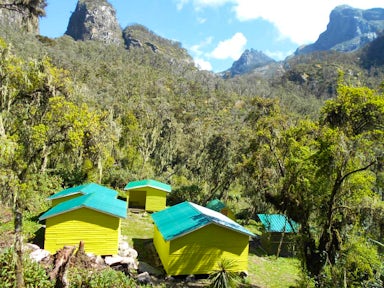
Kiharo camp in the Rwenzori foothills.
Climbing upwards, approaching the summit and looking down, it hits you all at once. The scope of the ridge is immense. Staggering for roughly 40 miles, it is unsymmetrical, non-conforming. In some places, the valleys are as narrow as a country lane, in others the gap between ridges is vast, filled with plants, lakes and streams.
From this vantage point, you can see the Rwenzoris snaking across the landscape, joining and splitting and joining again. Only six of the massifs make it beyond 4,500 metres, separated by deep gorges. You can’t see what lies beneath, a floor of clouds - often indistinguishable from the snow beneath your feet - covers the gaps. These peaks appear weightless, detached from the rest of the world.
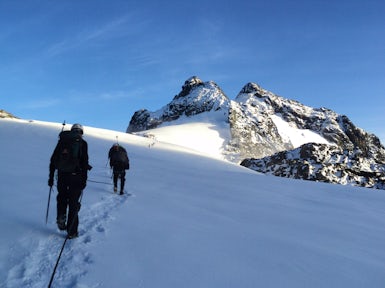
Summit push to Margherita peak.
Emerging at the summit feels a world away from the wild forests and cascading waterfalls of the lower slopes. It is as though by passing through the clouds, you have passed through a veil and clambered into a completely new land.
The snow stretches out like a blanket placed haphazardly, but smooth and untouched. Rocky knots emerge in small crests here and there, peeking up through the snow as though they were stepping stones, inviting you to continue skyward towards the very top.
The sign that marks Margherita Peak at 5,109 metres sits upon an arrangement of rocks crowned with melting snow. Standing here, you feel the sense of accomplishment - you’ve been working for this for over a week now. Time to pause, take in the brilliant blues of the sky that envelops everything north of the horizon, and the whites of cloud and snow that claim everything below it.

Reaching the summit, Margherita Peak
Ready to explore the Rwenzoris?
How Can We Help You?
We love helping people plan adventures to Uganda, and with a network of local partners and years of experience, we can help you decide when to travel, where to go and what to see.
Ready to explore Uganda?
Listen
We'll spend some time listening to your aspirations, then discuss the kind of experience that might suit you.
Match
Next we'll discuss the options, shortlist the best trips for you and present you our impartial recommendations.
Reserve
We'll place a 24 hour hold on your preferred option - without obligation - whilst we talk through the details.
Whatever your budget, group size, length of stay, preferred activity or appetite for adventure, we can help.
+1 315 645 2889

